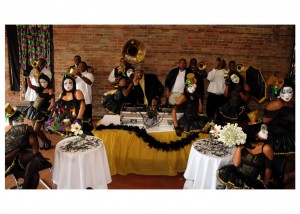Mardi Gras Indians are, at this point, a well-understood phenomenon. There have been scholarly studies, pop-culture head-nods, and heaps of plaudits from the larger community. This should have been the fate of the Baby Dolls, Millisia White thinks, and it’s a gap in our Carnival consciousness that she and her Baby Doll Ladies are looking to correct.
The beginnings of the Baby Doll organizations are less than clear. Dr. Kim Vaz, the Associate dean of Arts and Sciences at Xavier University, points to the travelogues of Robert McKinney as a starting point. He notes that in the black community, there was competition between denizens of different areas of Storyville to be “prettiest” on Mardi Gras day. It would appear that Leola Tate in 1912 led a group of women dressed as “sassy” baby dolls, and won the affections of the community. From there the group grew and then splintered. The Golden Slipper Baby Dolls and Gold Digger Baby Dolls came out of Tate’s ensemble, and their popularity swelled. The troupes were more than just dancing crews; they served as a makeshift social aid and pleasure club.
New Orleans Baby Doll Ladies’ founder Millisia White takes inspiration from the struggles of black women during that pre-Depression period. “You should never complain when you see the struggles they were up against,” she says. “Racial discrimination, sure, but also on a gender basis. That’s a lot. And they owned businesses. These women were smart! Mardi Gras was the day that they used to garner business. They’d send a band out in their name, get the word out.” But these clubs accomplished even more in the community. “They only masked once a year, but these were women who had an attitude of excellence and perseverance of will that was a way of life. Prayer and pageantry were there all the time.” The legacy of these early organizations lives on largely because of that profound and positive impact on the broader community.
The Baby Doll tradition disappeared sometime around the construction of the I-10 overpass on Claiborne Avenue during the 1960s, which decimated the region that had birthed the Dolls. Ironically, though, it was another tragedy that led to the resurrection of the Baby Dolls.
White had already formed her New Orleans Society of Dance company before Katrina, but the storm forced her to look at her priorities in a new light. “I think with every crisis, natural catastrophe or whatever, you get a sense of threat of what you know being lost, being gone. It’s scary. It’s inspiring. That’s your motivation. When Katrina hit, my brother DJ Hektik was like, ‘What do you want to resurrect?’ Dance. What’s synonymous with female dance in New Orleans? Baby Dolls.”
The Baby Doll Ladies are concerned with respecting tradition, but as White puts it, “When we coined ‘Resurrection,’ we weren’t saying we’re going to resurrect 1912. We’re not a replica—we’re a continuation. We’re trying to cultivate it. A little bit of old with the new. I appreciate a lot of the positive that generations before us have brought to it, but in reference to style, image and approach—look, it’s 2012. Let’s crank it up.”
This has led to a perceived schism between the more traditional approach favored by the late Antoinette K-Doe and her friends, who revived the tradition in 2004, and the more modern brand being put forth by White. But to hear her tell the tale, most of the elders appreciate anyone at all bringing their beloved tradition back into the limelight.
Since the roots of the Baby Doll tradition lead back to 1912, this year will mark a century of this ritual’s preservation. White and the Baby Doll Ladies have plenty planned, including rolling with Zulu. Ironically, the original Baby Dolls reportedly turned down Zulu, preferring autonomy. These Baby Doll Ladies will be accompanied by DJ Hektik as they blend the street chants of old and hip-hop from today. White sees this as a singular opportunity for her and the movement she’s aiming to resuscitate. “We’re proud to be able to put on our centennial debut. I hope y’all are ready.”





